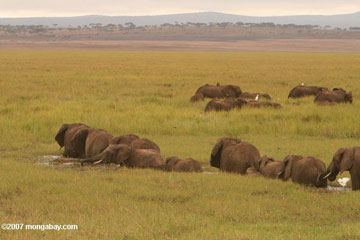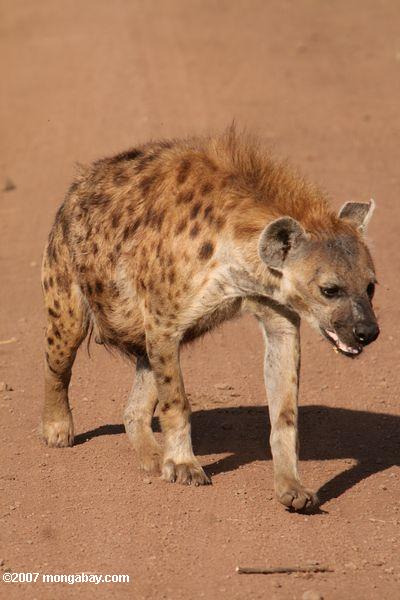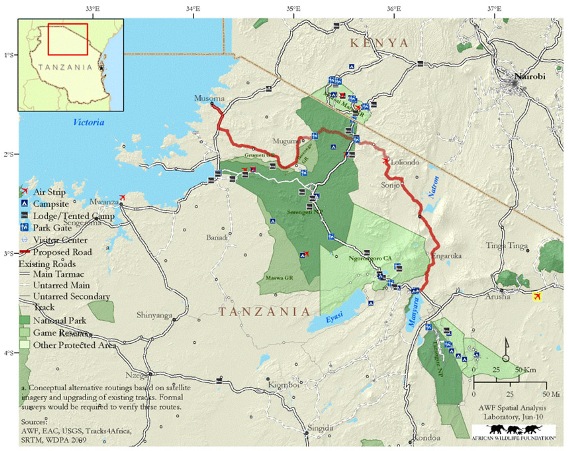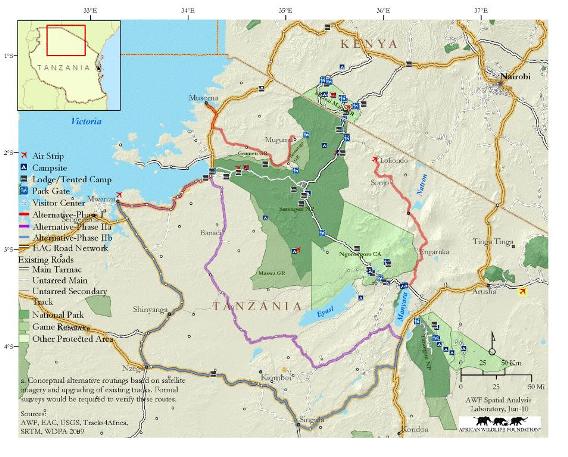To read more about Tanzania’s recent announcement related to the Serengeti road: Richard Leakey: ‘selfish’ critics choose wrong fight in Serengeti road.
After a week of confusion, the Tanzanian government has finally clarified its position on the hugely-controversial Serengeti road. The Minister for Natural Resources and Tourism, Ezekiel Maige, confirmed that a paved highway will not be built through the northern Serengeti National Park, however the government is still planning to construct a gravel road through the park. Yet critics have long warned that even an unpaved road would open Pandora’s box: eventually commercial and population pressure would push the road to be paved, widened, and fenced leading to a collapse of the world’s largest remaining-and most famous-land migration. Two million wildebeest, zebra, and Thomson’s gazelle pass along this route in annual migration from Tanzania to Kenya.
“The Serengeti road project has not been abandoned…we have just revised it. I don’t know where all this confusion comes from,” Maige told Reuters. “The project is still there without a shadow of a doubt. But the road will be unpaved, so there will be no tarmac road or highway traversing through the Serengeti National Park.”
 Elephants in Tanzania. Photo by: Rhett A. Butler. |
From the minister’s statement, it at first appears that Tanzania’s road plans have undergone little material change, despite news reports (see mongabay.com’s article on the initial announcement to rescind the road) and statements out of the UNESCO World Heritage Committee Meeting. Tanzanian President, Jakaya Kikwete, has long said the road would be unpaved, but the problem was no one believed it would remain gravel indefinitely. Tanzanian government documents have predicted that by 2015, 800 vehicles per day would cross the proposed 30 mile (50 kilometer) road and by 2035, the number of vehicles per day is expected to rise to 3,000, or well over a million a year. The construction of such a widely-used road was opposed not just by environmentalists, but by scientists, the UN, the German government, the US government, and a major Tanzanian tourism lobby group for its threat to the Serengeti migration.
According to critics, the road would not only imperil the migration, but would devastate tourism to Tanzania. Currently, around 150,000-200,000 people visit Serengeti National Park annually. A recent study in the open-access journal Tropical Conservation Science found most tourists come to see wildlife, especially big cats. This is bad news for tourism as a government analysis warned the road would impact big predator populations in the park due to a decline in prey base. In addition over half of the 350 tourists interviewed said they would not return to the park if more roads are constructed.
Yet there is one major change in the road plan that has given critics some hope: access will now be managed by the Tanzanian park authority (TANAPA) instead of the government’s highway agency.
“The original plan was to excise a whole strip of the Park and place it under the Tanzanian road authority. And that decision, perhaps the most important of all, has been rescinded,” Dave Blanton of the NGO Serengeti Watch told mongabay.com. “In short, there was enough assurance from the Tanzanian government that the World Heritage Center has kept the Serengeti off the List of World Heritage Sites in Danger.”
Maige confirmed that game rangers would be given authority regarding road management.
“The road will be closely supervised. TANAPA will put up gates and carry out regular patrols to ensure no harm comes to the wildlife population as a result of vehicles that will be allowed to pass through the road.”
The government’s announcement stated that the road would be used mostly for official capacity and tourism. Yet, there will be undeniable pressure to open it up for commercial and general public use.
Blanton says this isn’t the victory that was initially reported, though the Tanzanian government does deserve some credit for the changes to the plan.
“We are grateful for the government’s decision. We are grateful to the World Heritage Committee, the Frankfurt Zoological Society, and especially those in Tanzania who worked to make this happen. And we’re grateful for the international community that came to the support of the Serengeti. But we are not celebrating. We’ve dodged a bullet, and we’ve been given more time.”
The gravel road will pass through largely unused parts of the park, which have been categorized as off-limits even to tourist vehicles.
“A key issue is for the government to follow its own, excellent 10-year Serengeti Management Plan. This plan designates the northern area as Wilderness and Low Use Zones, restricting use largely to official traffic,'” Blanton points out. Currently, only walking safaris are allowed in the area.
 Hyena in Tanzania. Photo by: Rhett A. Butler. |
Tanzania has argued that it needs the Serengeti road to link up northern communities that currently have little-access to resources and markets. However, the German government-in an attempt to conserve the Serengeti-offered a plan to build local roads for the communities that wouldn’t cross the park. In addition, the World Bank has offered to fund a southern road which would circumvent the Serengeti altogether, but still allow a route for commercial traffic.
Blanton says funding and building the southern route is ‘the most important step now’ to preserve the Serengeti.
“This route is preferable to the northern route for maximum social and economic development. And it will allow a relief valve for traffic, present and future, that would travel through the Serengeti itself. The government letter says it was ‘seriously considering’ this. We need to support this effort and make sure it is accomplished. Otherwise, we’ve not gone forward,” he argues.
While ostensibly the road has been pushed as a way to link up far-flung communities, Tanzania is also targeting a route to bring raw materials from the African interior to the coast for shipment abroad.
“The underlying threats are really the cause of this latest crisis, which was just a symptom of them. The people of Tanzania need better lives, more opportunities, and development,” says Blanton. “Their population is young and growing. These pressures demand that the great natural areas Tanzania has set aside must pay their own way. There are great geopolitical forces operating in East Africa. There is oil in Uganda and the Sudan that will need an outlet, primarily destined for China. There are gold mines around the Serengeti. Countries like the Congo, Rwanda, and Burundi are landlocked and need ports for their minerals. All this will play out in a massive way in the coming years. The Serengeti is in the middle of all of this.”
In an effort to boost GDP, President Kikwete is also pressing to mine soda ash in the world’s most important breeding ground for lesser flamingoes, Lake Natron, and build a new sea port on Mwambani Bay, which critics say imperils a marine park established to preserve the living-fossil, the coelacanth.
The UNESCO World Heritage Committee meeting also granted Tanzania the go-ahead to downsize Selous Game Reserve by 34,532 hectares (less than 1 percent of the over 5 million hectare park) in order to mine for uranium.

The proposed road would cut through the northern end of Tanzania’s Serengeti. AWF has proposed a southern route circumventing the ecosystem in its entirety. Map by the African Wildlife Foundation (AWF). Click to enlarge.
AWF’s proposed alternative. Map by the African Wildlife Foundation (AWF). Click to enlarge.
Related articles
How do tourists view the Serengeti?
(06/27/2011) Serengeti National Park in Tanzania, an immense expanse of East African savanna, is a world famous tourist destination because of its plentiful megafauna, particularly the great migrating herds of wildebeest. Yet despite huge visitor numbers and the annual revenue of millions of US dollars, local poverty and increasing population continue to imperil the reserve. A new study in mongabay.com’s open-access journal Tropical Conservation Science found that while tourists to the Serengeti overall report a high degree of satisfaction with their trip, they are concerned about the future of the ecosystem.

(06/23/2011) In what is a victory for environmentalists, scientists, tourism, and the largest land migration on Earth, the Tanzanian government has cancelled a commercial road that would have cut through the northern portion of the Serengeti National Park. According to scientists the road would have severed the migration route of 1.5 million wildebeest and a half million other antelope and zebra, in turn impacting the entire ecosystem of the Serengeti plains.

(04/14/2011) What’s happening in Tanzania? This is a question making the rounds in conservation and environmental circles. Why is a nation that has so much invested in its wild lands and wild animals willing to pursue projects that appear destined not only to wreak havoc on the East African nation’s world-famous wildlife and ecosystems, but to cripple its economically-important tourism industry? The most well known example is the proposed road bisecting Serengeti National Park, which scientists, conservationists, the UN, and foreign governments alike have condemned. But there are other concerns among conservationists, including the fast-tracking of soda ash mining in East Africa’s most important breeding ground for millions of lesser flamingo, and the recent announcement to nullify an application for UNESCO Heritage Status for a portion of Tanzania’s Eastern Arc Mountains, a threatened forest rich in species found no-where else. According to President Jakaya Kikwete, Tanzania is simply trying to provide for its poorest citizens (such as communities near the Serengeti and the Eastern Arc Mountains) while pursuing western-style industrial development.
Serengeti road project opposed by ‘powerful’ tour company lobby
(03/16/2011) Government plans to build a road through Serengeti National Park came up against more opposition this week as the Tanzanian Association of Tour Operators (Tato) came out against the project, reports The Citizen. Tato, described as powerful local lobby group by the Tanzanian media, stated that the road would hurt tourism and urged the government to select a proposed alternative route that would by-pass the park. Tato’s opposition may signal a shift to more local criticism of the road as opposition against the project has come mostly from international environmentalists, scientists, and governments.
First International Serengeti Day hopes to halt road project

(02/23/2011) On March 19th the conservation organization, Serengeti Watch, is planning the world’s first International Serengeti Day to celebrate one of the world’s most treasured wildlife ecosystems. But the day also has another goal: bring attention to a Tanzanian government plan to build a road that would essentially cut the ecosystem, threatening the world’s largest mammal migration. “The proposed road will be a major commercial route that cuts across a narrow stretch of the Park near the border with Kenya. It goes through a wilderness zone critical to the annual migration of 1.3 million wildebeest and 0.7 million zebras, antelope, and other wildlife. This will involve extracting a strip of land from the Park itself, resulting in both the fragmentation of the ecosystem and the removal of the Serengeti National Park from the list of UN World Heritage Sites,” said David Blanton, co-founder of Serengeti Watch, in an interview with mongabay.com.
Leaked government study: road will damage Serengeti wildlife, despite president’s assurances
(02/10/2011) Tanzania’s President, Jakaya Kikwete, today gave promises that his proposed road project, which will bisect the Serengeti plains, would not hurt one of the world’s most famed parks and one of its last great land migrations. “The Serengeti is a jewel of our nation as well as for the international community. […] We will do nothing to hurt the Serengeti and we would like the international community to know this,” Kikwete said in a statement reported by the AFP. However, a government environment impact study, leaked to the conservation organization Serengeti Watch, paints a very different picture of how the road will damage the Serengeti. The report includes warnings that the road will ‘limit’ the migration of the plains’ 1.5 million wildebeest and 500,000 other herbivores including zebra.
Scientists: road through Serengeti would likely end wildebeest migration
(02/02/2011) A new study finds that a proposed road cutting through Serengeti National Park would likely have devastating consequences for one of the world’s last great migrations. According to the study the road itself could lead to a 35% loss in the famed park’s migrating wildebeest herd, essentially cutting the herd down by over half a million animals. Despite such concerns, and the availability of an alternative route that would bypass the Serengeti plains altogether, the Tanzanian government has stated it is going ahead with the controversial road.
World Bank offers to save Serengeti from bisecting road
(01/31/2011) The World Bank has offered to help fund an alternative route for a planned road project that would otherwise cut through Tanzania’s world famous Serengeti National Park, according to the German-based NGO Nature and Biodiversity Conservation Union (NABU). When announced last year, the road project raised protests from environmentalists, scientists, and Tanzanian tour companies, but the Tanzanian government refused to shift plans to an alternative southern route for the road, thereby bypassing the park.
